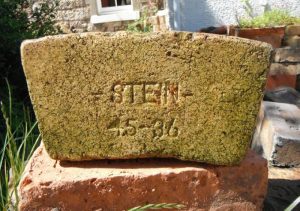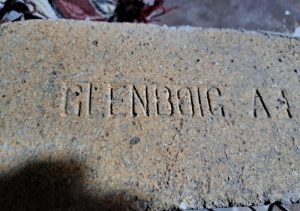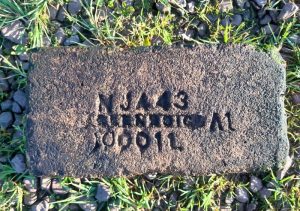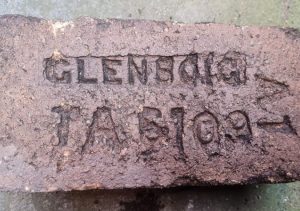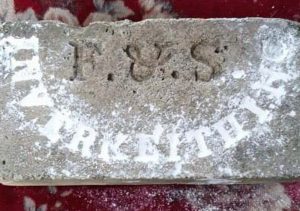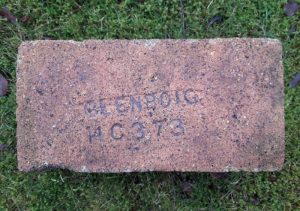Published in 1901. The following are the brick references contained within.
Bricks are largely made from the laminated clay beds of the raised beaches and of interglacial position, as also from the boulder clay, which is cleared of stones for that purpose. The fire clay beds of the coal measures and millstone grit series afford good material for the manufacture of fire bricks, gas retorts, and other furnace fittings, as well as various kinds of enamelware, while the red marls of the Calciferous Sandstone period, and the more highly ferruginous of the post-glacial clays, are used for the production of bright red bricks, tiles, pipes the so-called terra-cotta.
************************
Coltness (Coltness Iron Co.). Newmains Station, C.B. — These works were commenced in 1837 by Messrs. Houldsworth. It originally consisted of twelve furnaces, but the number has now been reduced to nine, which are of modern type, and larger than the old furnaces. Attached to the furnaces is a foundry for the casting of moulds for the steelworks direct from the blast furnaces^ and there are also a steel furnace, briquette plant, and brick works.
***********************
The method of distilling the bituminous shale was revolutionised in 1881-82 by the introduction of the Young and Beilby retort, which was designed for the purpose of subjecting the spent shale of the oil making retort to a further treatment with steam at a higher temperature than that suitable for oil making ; the primary object of this improvement was to convert the nitrogen left in the spent shale into ammonia. In the Young and Beilby retort, the upper half is made of iron, and the lower half of fire brick; at the top of the retort is a hopper containing shale, which is heated by the hot gases passing np from the retort below. As the whole column of material in the retort is moved down by the removal of a part of the spent ash at the bottom, the shale passes in succession through the iron retort and the fire-brick oven. In the former, it is exposed to a low red heat, and parts with its hydrocarbon oils and paraffin; in the latter, where it is heated to bright redness and exposed to the action of steam, the carbon is more or less completely burned away in steam, producing water gas and ammonia. The retorts are placed in chambers of fire brick and are heated by producer gas, which is burned along with the uncondensible gas in narrow flues around the retorts. In order to facilitate the removal of the spent ash, and thus to minimise the danger arising from fusion of the ash at the high temperature of the brick chamber, the retort is provided with an easily accessible curved mouthpiece and door at the bottom. This system of distilling the shale at two different temperatures has the effect of greatly increasing the yield of ammonia and of the valuable paraffin scale as well, as can be seen from the following figures : —
1882 Retort 1897 Young and Beilby Retort
Burning oil from 1 ton of shale, 12.6 gallons 12.9 gallons
Lubricating oil ” 5.4 gallons 5.4 gallons
Paraffin scale ” 3.3 gallons 4.3 gallons
Ammonium sulphate ” 12 lbs 36 lbs
These retorts were very generally adopted, and the system of distilling the shale at two different temperatures has been applied in all the more recent retorts which have been designed as improvements upon the original Yoimg and Beilby type. The chief changes in the newest forms of shale retorts, apart from structural details, are an increase in the capacity, so that the shale remains a longer time in the retort and the adoption of various mechanical devices for the removal of the spent shale ash; the main results of these improvements are a great reduction in the cost of retorting and an increased yield of crude oil and ammonia.
In the chemistry of refining the crude oil, there has been little or no change. Sulphuric acid is used to remove basic tars and resinous substances, and caustic soda solution for the removal of creosote tars and sulphur compounds; the different oils are separated by fractional distillation, and the paraffin by cooling, crystallisation, and filtration. The quality of the lubricating oil has been improved by distilling the heavy oils off caustic soda, by the plentiful use of superheated steam in the distillations, and by the adoption of improved freezing machines and filter processes. A great advance in the distillation process was made when M. Henderson designed his apparatus for continuous distillation. In this system, the stills are arranged in series, and the oil flows from charging tanks through each still in succession, undergoing fractionation in its course. The most volatile fractions are distilled off from the first still and the least volatile from the last. The use of this process has resulted in a considerable economy in labour, fuel, maintenance, and chemicals and the loss in refining has been materially reduced.
**********************
Fire brick and fire clay – Extensive deposits of fire clay exist in Lanarkshire. These were worked to a small extent in making very moderate quantities of fire brick until well on in the early part of last century when the extensive fields in the neighbourhood of Garnkirk and Glenboig were discovered. The fire clay is got here at no great depth, and the seams are especially thick. It is in these districts that the trade has had its greatest development. From very small beginnings the making of fire bricks grew alongside the iron and steel trades and latterly has become the great industry which makes it so prominent a feature in the West of Scotland.
The fire clays in the neighbourhood of Glasgow are situated geologically in the upper coal series and limestone series. They are found at all depths, from the surface open-cast workings to pits 40 or 50 fathoms. The workable seams vary in thickness from about 3 feet to 30 or 40 feet. The process of fire brick making is pretty much the same all over the West of Scotland. For precision, we will briefly follow the process as applied at the Glenboig works. The clay is there found 113 feet deep and varies in thickness from 6 to 9 feet. In descending the shaft, we pass through from 12 to 20 feet of floating whinstone, which covers a considerable part of the Glenboig district; under this are numerous beds of fire clay and siliceous rocks, some of them almost pure silica. The system of mining is what is called stoop-and-room. The workings are 12 feet wide, and the stoops left in are 30 feet square, excepting at the pit bottom, where they are much larger. The stoops may be cut through, and when the proper time comes removed altogether. The clay in its natural state is very hard and requires to be blown down with gunpowder. The average daily output of each man is from 4 to 5 tons, according to the thickness or the hardness of the clay. The clay is sent out in pieces about the size of ordinary coal. It is raised to a high pithead platform, whence it is run either to the crushing mill direct or to the bing, where it is exposed to the action of the weather.
In bricks, for general furnace purposes, a close texture is not required. The brick must have sufficient flour in it to give it toughness and strength so that it may bear the rough shunting of our railways, and the careless treatment which fire bricks too often receive in shipping and trans-shipping. But when that is accomplished, they are made as rough and open in the grain as possible, that they may be the better able to resist high and variable temperatures.
The crushing and milling are effected by means of revolving pans, in which heavy iron-edge rollers run. The clay is first broken with hammers, and shovelled into the crushing mill, the bottom of which has perforations through which the clay is crushed. Scrapers attached to the pan beneath throw it into an iron box, whence it is lifted by means of an endless chain fitted with elevator buckets, and delivered into a cylindrical riddle 8 feet long and 2 feet in diameter. This is so placed that the riddled clay drops to a second set of elevators, while the pieces too large to pass through drop back into the crushing mill. The second set of elevators has two duties to perform — it either sends the fine-ground fire clay, which is used as mortar in furnace building, to an endless belt, which carries it to the waggons on the railway outside, or the rougher brick clay to the tempering pans by means of a box 60 feet long placed overhead. In this box, there is a travelling chain fitted with clots, by means of which the clay is dragged along. In the bottom of the box are holes to which conductors are attached, one to each mill. These, from their position, are always kept full, and when the millman requires clay he has only to draw a sluice at the lower end of the conductor and the clay drops into the pan. He then turns on the water, and the mill is charged in a second or two. For mortar clay, a fine riddle is used, and for brick clay one of larger mesh. In preparing clay for glasshouse blocks, gas retorts, Bessemer tuyeres, and all large articles, a proportion of previously burnt bricks or clay is added, to prevent cracking in the drying and burning. Dry mills are generally employed for tempering when the clay is of a soft aluminous nature, but they are not suitable for hard, gritty, siliceous clays. When ready for moulding, the clay is discharged into small tipping bogeys, which are raised by means of a steam hoist to the upper floor of the drying store. It is there run along a little railway, whence it is dropped down through suitable openings to the moulders’ benches. By this method, one man delivers the clay to nine or ten moulders. It has also the advantage of taking the trafl&c off the drying floor. Once in the moulders’ hands, the clay is rapidly turned into bricks. A good workman, with his carrier, will make 2500 bricks a day. Solid brass moulds are used for regular sizes, but for the larger sizes, wooden moulds are employed. Iron, zinc, and glass have been tried, but hard brass has many advantages. The moulds are made one-twelfth larger than the size of the burnt brick, to allow for shrinkage. The face board on which the brick is made is covered with thick ” plaiding,” and the trademark is fixed upon it so that making and stamping are performed in one operation. No machine has yet been made capable of taking well-milled fire clay as it leaves the pans, turning it rapidly into bricks, and delivering them, square and sharp-edged, on the pallet-boards. When the brick is moulded by hand, the moulder discharges it on to a pallet board; the carrier then places another board on the top of it, and between the two the soft brick is carried with safety and deposited on edge on the stove floor, where it remains till it is hard and ready for the kiln. The defects most common in fire brick (with the exception of soft burning) are produced in the stove, and it is here alone that soundness and finish can be given to them. If the stove floor is uneven, the shape of the brick is spoiled, and if too much heat is applied the bricks are warped and cracked. Some clays are very liable to crack when too quickly dried, and where stoves are badly constructed this occasions loss and injures the quality of the brick to a serious extent. Bricks of this description give also increased breakage in the kiln and, indeed, in every stage of their existence. To meet all this, a patented construction of stove is employed at Glenboig. The stoves are 120 feet in length by 36 feet wide and are fired from one end. The drying floors are entirely formed with cast-iron plates, each 4 feet by 2 feet by 5/8 of an inch. These are smooth and easily heated. Underneath the iron floor, there is another, formed of fire-clay slabs, about 3 inches thick, which run from the furnace end to the middle of the stove, a distance of 60 feet. The fires and hot flues are underneath the fire-clay slabs, and between the fire-clay slabs and the iron plates forming the upper floor, there is an air space 8 inches deep. This communicates with the outer air at the gable over the fires. Each flue has its own air space. By this means the stove may be fired up so as to heat effectually the back end, while too much heat in the furnace end is prevented by the current of cold air passing between the two floors. The air so admitted joins the lower flue at the middle of the stove, carrying with it the superfluous heat at the furnace end, and utilising it where it is required. Each stove of the dimensions named turns out 24,000 bricks a day. Every brick is ready for the kiln the day after it is moulded. By this system of drying the cost is lessened, while the production for a given space is nearly doubled and the quality much improved. Various methods have been tried, such as exhaust steam in pipes or flues, and hot air in a variety of ways. The method just described gives steady night and day drying, as it is not dependent on the boiler being off or on, and is in every respect to be preferred, particularly where large production and perfect regularity are required. When dry, the bricks are wheeled to the kilns. The firing is done very gently at first. This is continued for two days, till the damp is completely steamed out of them. The kiln is then put on full fire, which is kept up for about two days, during which a bright white heat is steadily arrived at, this being maintained till the sink in the bricks has taken place, when the firing ceases and the kiln gradually cools The making of a fire brick is like the making of a pin — the article looks a simple one, yet the process is complex and somewhat elaborate. In no process is close and continued attention more essential if the best results are to be obtained. As in scientific investigation, the smallest gleam of truth has its value and its place, so in the workshop, every ascertained fact has its value also, and if it gets its place it will bring its reward in the general result.
A brick rich in silica, yet containing a fair proportion of alumina, and comparatively free from alkalis and other impurities, is the one which combines in the highest degree infusibility and freedom from splitting, and is consequently found to be best suited for the greatest number of the most important furnace purposes, such as puddling, rolling mill and forge furnaces, gas retorts, etc., where the great desideratum is the combination of these qualities. The following is the analysis of a Glenboig brick by Sir Frederick Abel, F.B.S., taken from the stock as used at the Royal Arsenal, Woolwich ; —
Silica, 62.50
Aluminium, 34.00
Iron peroxide, 2.70
Alkalis loss, etc., 0.80
Two clays might be found giving a similar analysis which would yet produce very different fire bricks. In this very analysis, we have a case in point. The silica and alumina are largely combined as a silicate of alumina, and this is much to be preferred to a clay possessing the same proportions of these substances but not chemically combined.
It is not surprising, therefore, that these bricks are extensively used at home, and that their use has spread to England, gradually over Europe, and latterly, it may be said, to almost every part of the globe. Wherever they have gone they have made for themselves a reputation and a market which grows from year to year.
Many other articles are made from this fire clay, notably gas retorts made in one piece, and also blocks for built gas retorts. Sewage pipes are also made in great quantities and of all dimensions, and as sewage works are now being constructed in many lands these pipes are being regularly shipped to many foreign countries. Attention is also given to the requirements for special furnaces, such as glassworks, where large blocks of varying size and shape are required. The manufacture of bricks with a white glazed surface is another branch of the trade which is rapidly developing here. These are being increasingly used for facing walls in backcourts, underground railway stations, etc. Several makers are giving special attention to the development of this branch.
It is interesting to know that in this connection several of the fire clay makers in the West of Scotland are working at sanitary ware, not only at articles of a coarse description, such as sinks, roughs, urinals for railway stations, etc., but also at what may be considered as the better articles, such as water-closet pans, wash-hand basins, etc. This branch is already of considerable dimensions, and, like the other branches, it is expanding with rapid strides. Chimney cans in greatly varying shapes and sizes, roof ridges, copings of walls, bottoms for sewers, vases, and other ornamental articles for use in gardens, the forms of some of which are admittedly fine, and claim to have artistic merit, are likewise made. There are other things which all show how this manufacture — starting with fire bricks, which still are its backbone — is spreading out to most varied productions.
One or two of the makers show vases and other ornamental articles for garden use, and the forms of some of them are undoubtedly good and artistic.
This brief reference, which is far from being exhaustive, to the varied nature of the fire-clay trade gives some idea of its great development. The manufacture stands out as one of the most growing industries of the district and is carried on with great enterprise. Skill is displayed in the methods and processes of manufacture, and the business is pushed with energy in every part of the world.
Before concluding, reference must be made to a patent kiln invented by Mr Dunnachie, the well-known managing director of the largest fire-clay works in the district. It is known as the regenerative gas kiln or oven. Whilst its main feature is the use of gas as the heating agent, it is also to some extent of the nature of a continuous kiln or oven — the heat from the kiln directly fired being carried into the next, while the air for combustion is passed through the one that had previously been fired, thus coming into contact with the gas at a high temperature. It has been in use for a good many years, and its success has long been established in this country and elsewhere, notably in America. It not only does the work well by producing thoroughly burnt bricks but is far more economical than the ordinary method of burning fire bricks.
At least one firm gives special attention to what are known as adamantine bricks, etc. These are exceptionally hard. They are used for the paving of railway stations, stables, etc., and are of special value for the foundation of tall chimneys and other erections, as they are able to bear almost any pressure from the superincumbent material. The trade employs quite an army of workmen, and its production is enormous, the quantities sent out from Glasgow being a feature in the shipping trade of the city. Moreover, it is a trade which seems to have no bounds to its rapid growth, which has now continued for so many years.
Common building bricks – Around Glasgow there exist extensive beds of good clay for brick making. In many instances, these are not exhausted by the brick maker before the builder comes on the scene and drives him off. But the brick maker only moves further afield, and on fresh ground resumes his operations, so that now, in almost every direction around the city, the familiar brickfield is to be seen. Owing to the abundance of stone in the West of Scotland, bricks have been little used in the erection of dwellings, except in the building of partitions and, to a greater extent, of gables and back walls. They are, however, extensively used in the erection of workshops and factories of every kind. The clay, being well adapted for the purpose, makes excellent bricks, and factories are constructed in which practically no stone whatever is used, the bricks, when well burned, being exceptionally strong and solid. There are somewhere approaching forty millions of these bricks made in the neighbourhood of Glasgow annually, and the great bulk of these is used in the city and neighbourhood. There are fully one thousand men employed. These bricks are largely used in the erection of factory chimneys; indeed all such chimneys are built with this material in this quarter, and carefully burnt bricks are excellently adapted for the purpose, being well able to carry any weight that may be placed upon them. Formerly these common bricks were all made by hand, and as they were dried outside, brick making only continued during the summer months, the clay being prepared during the winter. But years ago some makers turned their attention to the possibility of making bricks by the aid of machinery, and ultimately with entire success. The machinery then adopted is still in use in this district, and is said to have been the forerunner of all such machines. These machines, combined with the adoption of drying sheds heated by steam and the use of the pug mill for preparing the clay, enables brick making to go steadily on throughout the whole year. As the city extends, there is also a natural increase in the number of bricks used.
Some ten years ago the interesting discovery was made that the great heaps of blaise which accumulate around ironstone pit banks, and which so frequently formed part of the landscape around Glasgow, could be turned into building bricks at a very moderate expense, as a certain portion of this material was partly combustible, and aided in the burning of the bricks. This material not being plastic, the process of making differs from that used for bricks made of clay. It is crushed into a powder, then it is placed in moulds, and the brick is formed under very considerable pressure. These bricks are burned in kilns constructed after the Hoffman plan. In exposed situations, bricks of clay are preferable, as it is thought they better resist the action of the weather; but these blaise bricks are used chiefly for inside partitions, gable walls, etc., and other places where there is no excessive pressure or exposure, and as they are cheap they are used somewhat extensively. Both of these branches of brick making have fully participated in the prosperity which has been enjoyed for several years in the building trade of the district.


